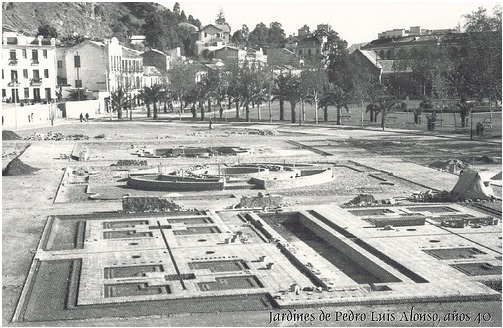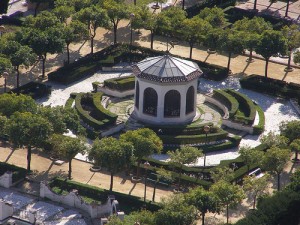Jardines de Pedro Luis Alonso, a garden I have only seen once -looking down from halfway up the hill towards the Gibralfaro Castle in Málaga (Spain)- prompted some of the general questions garden historians face when writing about a garden. Especially when the garden is not very familiar to them, or when information is not readilly accessible (in this case: because Spanish is a language I do not have a thorough command of).
The splendid photo above, taken in the 1940s, shows the central part of the garden in a pristine state of preparation. It almost looks like a textbook example of garden archaeology, with the different levels to which the excavators dared to venture in their efforts to get a grasp on the unknown garden they have found and whose layout they are trying to record. Photo by Xavieris.
And as historical gardens go, this should be an easy one: it is a 20th century design, laid out right next to the city hall of Málaga, so there should be no lack of trustworthy records. There probably aren’t, but I’ll leave those to the local enthusiasts to dig through. General sources I have access to show that the origins of such a ‘new’ garden -of minor importance, maybe, but still- can become quite unclear within a few decades.
Gardenvisit.com, for instance, says that the garden was designed in 1945 by the architect Guerrero Strachan, and that the design is an evocation of the dictatorial Franco years.
But Fernando Guerrero Strachan died in 1930, 15 years before he allegedly designed the garden -and a few years before Franco came to power. It is ofcourse possible that he made the design before his death, but that the actual execution of the garden -no pun intended- was delayed by the Spanish Civil War. Then this photo would mark the finishing of this garden in 1945, from a design made 15 years earlier.
That happens all the time, ofcourse, but then don’t go about linking this garden to a dictator who had not even surfaced when the design was made. I could be wrong, ofcourse (see my remark on not mastering the language). There is a recent article about this garden, in a Spanish journal that is not available to me here in The Netherlands. 1Macarena Recio Bueno and Francisca Pastor Pérez: ‘Los Jardines de Pedro Luis Alonso’, in: Boletín de Arte Nº 22, 2001, pags. 333-344. It would be great if someone who read that could comment on this post and explain what the true story is.

The aviary a month before it was removed. Photo by HvdE.
In the mean time, changes have been made to this garden in the 1,5 years that passed since I visited Málaga. The aviary, which used to house parrots, has been replaced by a rather bland looking statue of ‘El biznaguero’ (a local historical figure), which became redundant when the counsil refurbished the nearby Parque.
I cannot tell why the counsil removed the aviary, but be statue they replaced it with is not an improvement. Maybe the parrots were seen as a grim reminder of the period under General Franco. Let’s hope they are better off now.
Footnotes
| ↑1 | Macarena Recio Bueno and Francisca Pastor Pérez: ‘Los Jardines de Pedro Luis Alonso’, in: Boletín de Arte Nº 22, 2001, pags. 333-344. |
|---|


